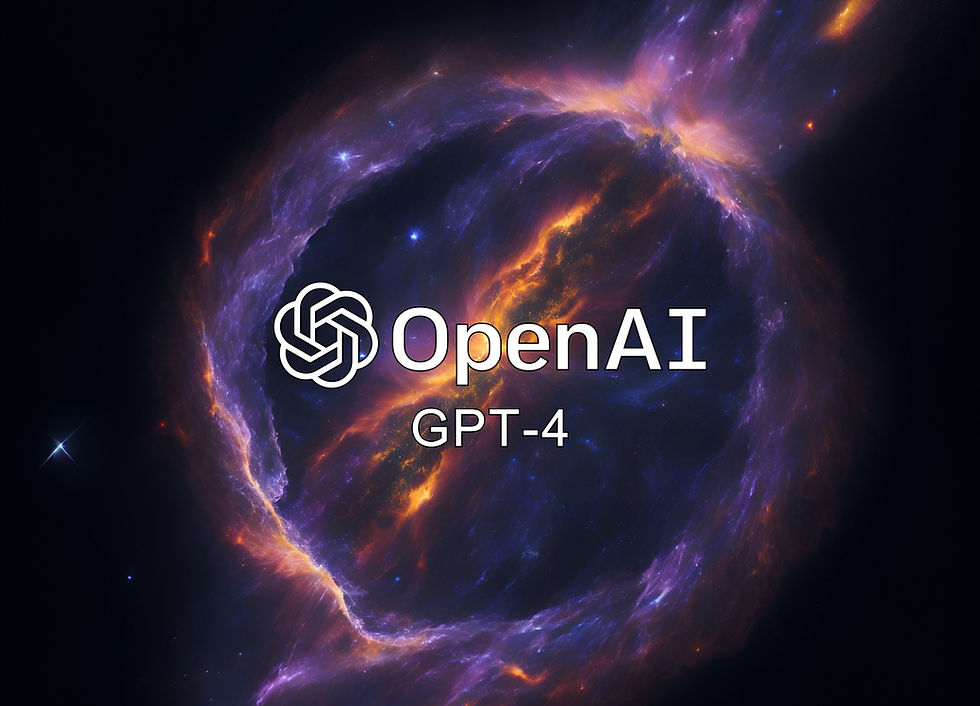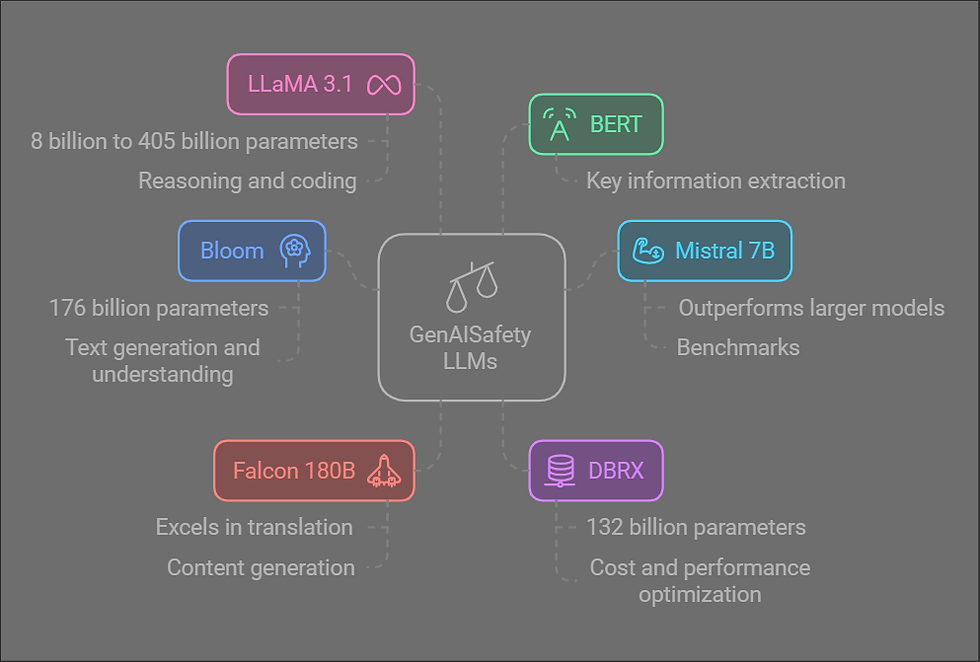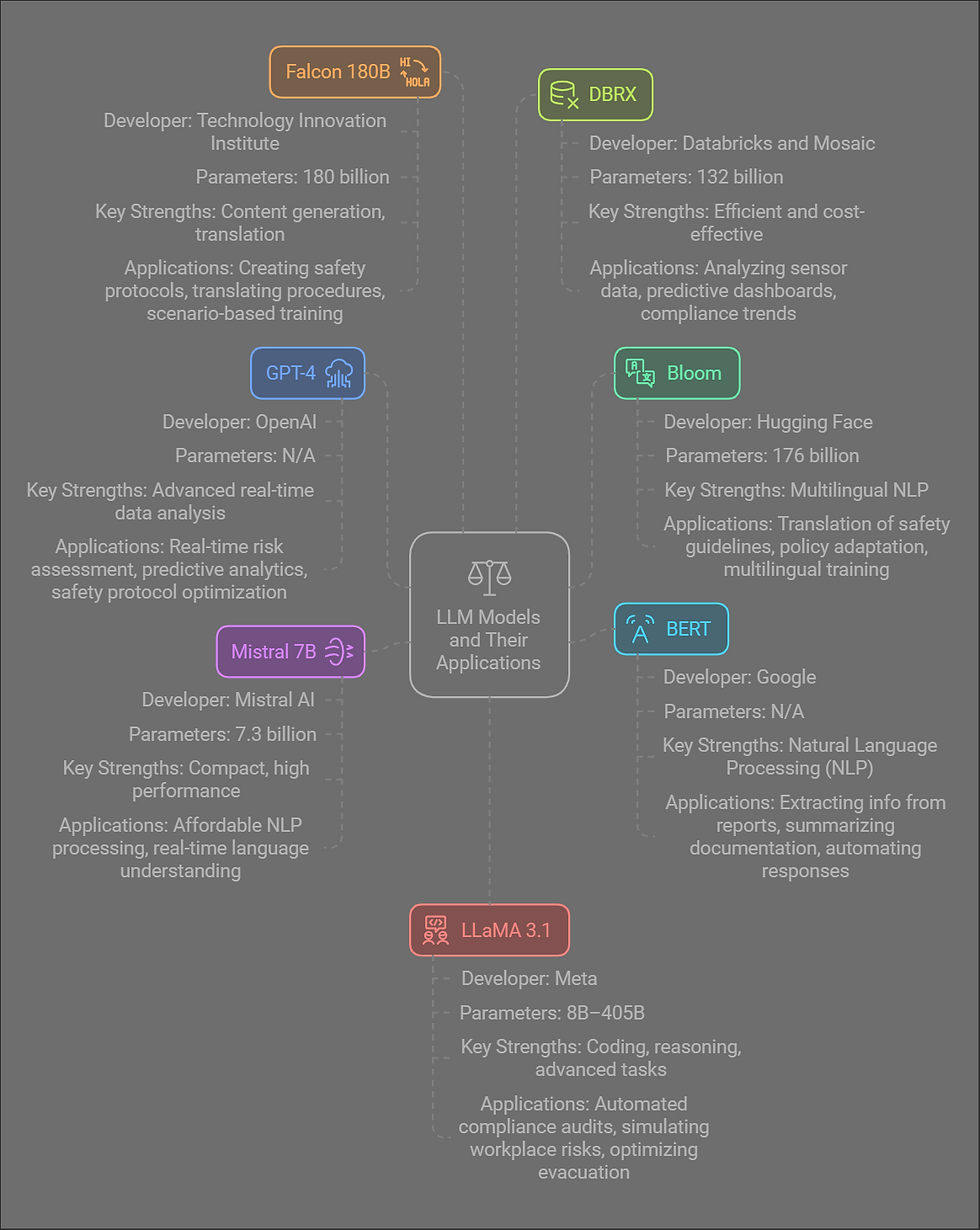Advanced Utilization of LLM Technologies in Workplace Safety: GenAISafety’s Approach
- L'équipe « SquadrAI»

- Dec 10, 2024
- 7 min read
Introduction
GenAISafety, a leader in workplace health and safety transformation, employs cutting-edge generative AI and open-source large language models (LLMs) to deliver innovative solutions.
This article outlines our approach, including the integration of advanced LLM technologies, rigorous benchmarks, and robust compliance with privacy regulations.
LLM Technologies Used
OpenAI Integration
GenAISafety incorporates OpenAI's GPT models like GPT-4, renowned for real-time data analysis and actionable insights to enhance workplace safety.

Open-Source Models

GenAISafety utilizes a diverse array of open-source LLMs:
Bloom: A multilingual model with 176 billion parameters for text generation and understanding.
BERT: A robust NLP model for extracting key information.
Mistral 7B: Compact yet powerful, outperforming larger models in many benchmarks.
Falcon 180B: A high-performance model excelling in translation and content generation.
DBRX: A successor to MPT-7B, boasting 132 billion parameters, optimized for both cost and performance.
Newly Added Technologies
LLaMA 3.1: Developed by Meta, this model ranges from 8 billion to 405 billion parameters, excelling in reasoning and coding.
Falcon 180B: Formed on 3.5 trillion tokens, this model is a cornerstone of high-quality NLP tasks.
Key Features of LLM Integration

Predictive Risk Analysis
LLMs analyze historical and real-time data to anticipate workplace hazards.
Virtual Safety Assistance
AI-driven virtual agents provide personalized recommendations for safety measures.
Training and Education
Interactive, AI-led safety programs enhance workforce awareness and preparedness.
Performance and Safety Benchmarks
Models are assessed with rigorous benchmarks like MMLU, BLEUScore, and HELM to ensure reliability and accuracy.
Compliance and Data Security
Privacy by Design
Adheres strictly to GDPR and Quebec’s Law 25.
Excludes sensitive data from all demos and applications unless explicitly permitted.
Table: Overview of LLM Technologies
Model | Developer | Parameters | Strengths |
GPT-4 | OpenAI | N/A | Real-time analysis and safety insights |
Bloom | Hugging Face | 176 billion | Multilingual NLP |
BERT | N/A | Natural Language Processing (NLP) | |
Mistral 7B | Mistral AI | 7.3 billion | Compact yet high-performing |
Falcon 180B | Technology Innovation Institute | 180 billion | Translation, content generation |
DBRX | Databricks and Mosaic | 132 billion | Cost-efficient, high benchmark performance |
LLaMA 3.1 | Meta | 8B–405B | Reasoning, coding, surpasses Claude 3 & Gemini |

Table of LLM Technologies with GenAISafety Use Cases

Model | Developer | Parameters | Key Strengths | GenAISafety Applications |
GPT-4 | OpenAI | N/A | Advanced real-time data analysis | Real-time risk assessment, predictive analytics, and safety protocol optimization. |
Bloom | Hugging Face | 176 billion | Multilingual NLP | Translation of safety guidelines, policy adaptation for global workplaces, and multilingual training material generation. |
BERT | N/A | Natural Language Processing (NLP) | Extracting key information from incident reports, summarizing safety documentation, and automating responses to workplace safety queries. | |
Mistral 7B | Mistral AI | 7.3 billion | Compact, high performance | Affordable, on-site NLP processing for smaller businesses, real-time language understanding for emergency responses. |
Falcon 180B | Technology Innovation Institute | 180 billion | Content generation, translation | Creating detailed safety protocols, translating emergency procedures into multiple languages, and generating scenario-based safety training simulations. |
DBRX | Databricks and Mosaic | 132 billion | Efficient and cost-effective | Analysis of workplace sensor data, creating predictive safety dashboards, and evaluating compliance trends using historical data. |
LLaMA 3.1 | Meta | 8B–405B | Coding, reasoning, advanced tasks | Automated compliance audits, simulating workplace risks using AI-driven logic, and optimizing emergency evacuation procedures. |
Highlights from the Table
🌟 Multilingual Solutions: Models like Bloom and Falcon 180B are pivotal in breaking language barriers for global safety compliance.
🔄 Cost-Effective Processing: Mistral 7B and DBRX are designed for affordable and efficient implementation, even for SMEs.
🚨 Emergency Readiness: Models like GPT-4 and LLaMA 3.1 focus on predictive analytics and automated reasoning to anticipate and prepare for workplace hazards.
📚 Training Tools: NLP capabilities of BERT and Bloom facilitate the creation of interactive, language-specific training modules.
📈 Real-Time Adaptation: GPT-4 excels in dynamic workplace environments by providing on-the-fly insights and recommendations.
Detailed Use Case Analysis by Category and Model for GenAISafety with Marketplace AI Products

Category | Model | Detailed Use Case | GenAISafety Product |
Predictive Risk Analysis | GPT-4 | Anticipates workplace risks using real-time data analysis. Identifies patterns and potential hazards, enabling organizations to implement proactive safety measures. | SafetyMetrics GPT, GPT-RiskControl |
AI-Driven Safety Management | GPT-4 | Offers training modules and educational content for HSE professionals to incorporate AI into risk management and safety practices. | ActionPrevention GPT, GPT-ActionPlanSST |
Compliance and Regulatory Adherence | Bloom, GPT-4 | Analyzes vast amounts of regulatory and compliance data. Provides actionable insights for adherence to safety standards, including region-specific laws like GDPR and Law 25. | Automated Compliance, Audits SST Automatisés |
Multimodal Capabilities | GPT-4o (Omni) | Processes text, images, and other data types to detect hazards in environments such as construction sites or industrial plants, using multimodal learning for better situational awareness. | VisionAI, BIM Digital Twins for Safety and Efficiency |
Virtual Safety Assistance | Mistral 7B | Continuously monitors workplace conditions and provides real-time recommendations to prevent accidents. Mistral 7B’s lightweight deployment enables cost-effective solutions. | SentinelAI, Health Safety Copilot |
Optimization of Safety Programs | DBRX | Analyzes workplace data to refine and optimize safety programs, reducing risks and improving productivity through advanced dashboarding and trend analysis. | Continuum SST, DynamicAssessor |
Mental Health and Well-being | Falcon 180B | Uses sentiment analysis to monitor employee well-being while ensuring privacy. Provides insights to support mental health initiatives. | Wellness & Ergonomics, AgriSafeAI |
Collaborative and Educational Resources | LLaMA 3.1 | Facilitates knowledge sharing among HSE professionals and offers access to the latest advancements in AI for safety and compliance. | GenAISafety Knowledge Hub, Training and Simulation |
Key Insights
Comprehensive Safety Management: Products like SafetyMetrics GPT and GPT-RiskControl leverage predictive capabilities for proactive hazard identification.
Advanced Compliance Solutions: Tools such as Automated Compliance use GPT-4 to analyze complex regulatory frameworks for seamless adherence.
Multimodal Applications:.SafeScan360. enables enhanced hazard detection by integrating text and visual data processing.
Mental Health Integration: Wellness & Ergonomics supported by Falcon 180B ensures employee well-being is a key part of safety strategies.
Customizable Risk Mitigation: Models like DBRX empower products such as DynamicAssessor to deliver tailored safety program improvements.
Detailed Analysis: Multimodal Applications in GenAISafety
Overview
Multimodal applications in GenAISafety leverage advanced models like GPT-4o (Omni) to process and integrate multiple data types—text, images, and structured data. These tools significantly enhance workplace safety by providing a comprehensive understanding of various safety hazards across industries.
Use Case 1: SafeScan360.
Capabilities:
Processes image data to detect unsafe conditions such as equipment malfunctions, structural risks, or worker non-compliance with safety protocols.
Integrates with workplace cameras and IoT sensors to provide real-time safety insights.
Generates immediate alerts for detected hazards, ensuring rapid response.
Example Applications:
Construction sites: Identifying structural weaknesses.
Manufacturing: Monitoring machinery for operational anomalies.
Model Used: GPT-4o (Omni)
Advantages: Enhances situational awareness by analyzing both visual and textual inputs in tandem.

Use Case 2: BIM Digital Twins for Safety and Efficiency
Capabilities:
Creates detailed, digital replicas of physical environments using Building Information Modeling (BIM).
Simulates emergency scenarios to evaluate and improve safety measures.
Allows predictive modeling of workplace changes to prevent risks before implementation.
Example Applications:
Simulating fire evacuation routes in high-rise buildings.
Testing new workplace layouts for ergonomic efficiency and hazard reduction.
Model Used: LLaMA 3.1
Advantages: Supports iterative improvements by integrating real-time feedback into virtual simulations.

Key Advantages of Multimodal Applications
Enhanced Risk Detection: Combining visual data with text enables the identification of risks that traditional systems might overlook.
Real-Time Insights: Continuous monitoring ensures timely interventions for safety violations or hazards.
Scalability: These applications can be deployed across industries, from small businesses to large-scale operations, with adjustable parameters for different settings.
Compliance Assurance: Automatic detection and reporting of compliance breaches help meet regulatory requirements efficiently.
Table: Multimodal Applications Overview
Product | Model | Capabilities | Industries |
SafeScan360. | GPT-4o (Omni) | Hazard detection via image analysis. | Construction, Manufacturing, Logistics |
BIM Digital Twins | LLaMA 3.1 | Digital replication and simulation of workplaces. | Real Estate, Industrial Design |
DynamicAssessor | DBRX | Predictive safety assessments combining inputs. | Healthcare, Retail |
Future Potential
Expansion into Wearable Integration: Multimodal AI can further incorporate data from smart helmets or AR glasses for on-the-ground worker safety monitoring.
Cross-Industry Customization: Tailoring multimodal solutions for niche sectors like mining or aviation could unlock new safety capabilities.
AI-driven Reporting: Automated generation of safety compliance reports combining visual and textual data for audits and inspections.

Wearable Integration in Multimodal Safety Solutions
Overview
Wearable technology integration with multimodal AI represents the future of workplace safety. By combining data from wearable devices (e.g., smart helmets, vests, AR glasses, and biometric monitors) with multimodal AI models like GPT-4o (Omni) and LLaMA 3.1, GenAISafety enhances real-time monitoring, risk detection, and decision-making capabilities.
Key Wearable-Integrated Use Cases

1. Real-Time Hazard Monitoring
Description:Wearable devices equipped with sensors capture real-time environmental data such as temperature, humidity, and air quality, alongside worker biometrics like heart rate and fatigue levels. Multimodal AI processes this data to detect unsafe conditions.
Example Applications:
Detecting heat stress in workers on construction sites.
Monitoring gas levels in chemical plants to prevent exposure to toxic substances.
Integrated Product:SafeScan360 Used: GPT-4o (Omni)
2. Augmented Reality (AR) for Training and Guidance
Description: AR glasses integrated with multimodal AI provide contextual, hands-free guidance to workers. Overlays can highlight hazards in real time or offer step-by-step safety instructions.
Example Applications:
Training new employees on machinery operation with live visual prompts.
Guiding workers through emergency evacuation routes during drills.
Integrated Product: Training and Simulation Suite
Model Used: LLaMA 3.1
3. Biometric Safety Alerts
Description:Biometric data from wearables (e.g., smart bands) allows AI to monitor workers' physical and mental health. Alerts are generated for signs of fatigue, stress, or irregular vitals, enabling timely intervention.
Example Applications:
Alerting supervisors if a worker’s heart rate exceeds safe levels during strenuous tasks.
Monitoring mental fatigue in healthcare workers for shift rotation recommendations.
Integrated Product: Wellness & Ergonomics
Model Used: Falcon 180B
Benefits of Wearable Integration
Enhanced Worker Safety:Wearables provide continuous monitoring, ensuring immediate detection of unsafe conditions or worker health risks.
Hands-Free Operation:AR devices allow workers to focus on tasks without manual interference, improving productivity and reducing distractions.
Data-Driven Insights:Wearables collect detailed, granular data that multimodal AI analyzes to identify long-term trends and improve safety protocols.
Scalability Across Industries:Solutions can be tailored for various industries such as construction, manufacturing, healthcare, and logistics.
Table: Wearable Integration Applications
Wearable Device | Integrated Model | Capabilities | Industries |
Smart Helmets | GPT-4o (Omni) | Detect impact, temperature, and proximity to hazards. | Construction, Mining, Warehousing |
AR Glasses | LLaMA 3.1 | Provide live visual overlays for safety instructions. | Manufacturing, Aviation, Education |
Biometric Monitors | Falcon 180B | Track worker vitals for health and fatigue monitoring. | Healthcare, Logistics |
Smart Vests | DBRX | Detect environmental factors like air quality and noise. | Chemical Plants, Oil & Gas |
Future Directions
Custom AI Models for Wearables: Models like Mistral 7B can be deployed locally on wearables for quick processing without relying on cloud infrastructure.
Blockchain for Data Integrity: Secure storage and verification of wearable-collected data using blockchain technology.
Predictive Maintenance: Integrating wearable data with IoT sensors for equipment health monitoring to preempt failures.
Collaborative Wearable Networks: AI that combines data from multiple workers’ wearables for holistic site safety monitoring.


Comments